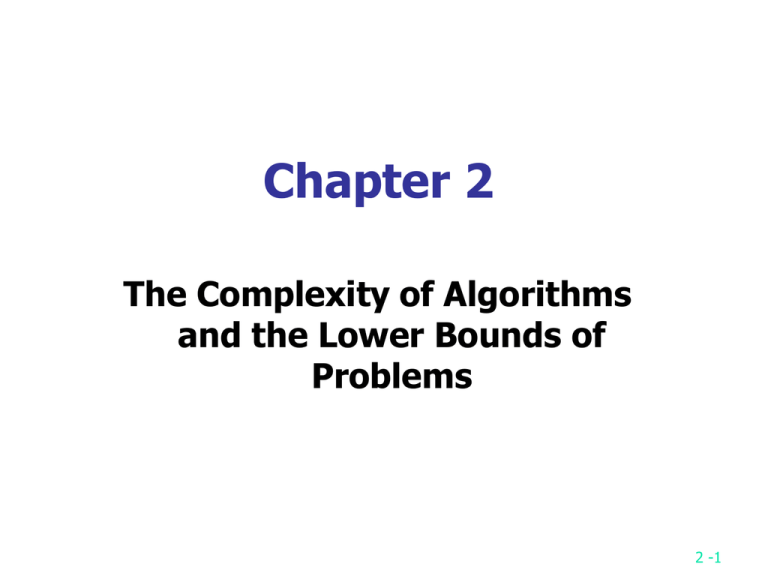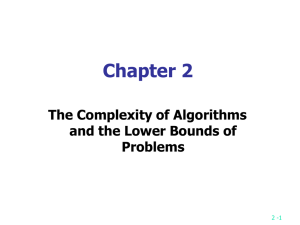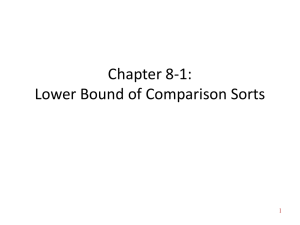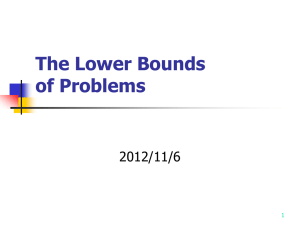Chap 2 Complexity and Lower bounds
advertisement

Chapter 2
The Complexity of Algorithms
and the Lower Bounds of
Problems
2 -1
The goodness of an algorithm
Time complexity (more important)
Space complexity
For a parallel algorithm :
time-processor product
For a VLSI circuit :
area-time (AT, AT2)
2 -2
Measure the goodness of an
algorithm
Time complexity of an algorithm
efficient (algorithm)
worst-case
average-case
Amortized
We can use the number of comparisons
to measure a sorting algorithm.
2 -3
Measure the difficulty of a problem
NP-complete ?
Undecidable ?
Is the algorithm best ?
optimal (algorithm)
We can also use the number of
comparisons to measure a sorting
problem.
2 -4
Asymptotic notations
Def: f(n) = O(g(n))
"at most"
c, n0 |f(n)| c|g(n)| n n0
e.g. f(n) = 3n2 + 2
g(n) = n2
n0=2, c=4
f(n) = O(n2)
e.g. f(n) = n3 + n = O(n3)
e. g. f(n) = 3n2 + 2 = O(n3) or O(n100 )
2 -5
Def : f(n) = (g(n))
“at least“, “lower bound"
c, and n0, |f(n)| c|g(n)| n n0
e. g. f(n) = 3n2 + 2 = (n2) or (n)
Def : f(n) = (g(n))
c1, c2, and n0, c1|g(n)| |f(n)| c2|g(n)| n n0
e. g. f(n) = 3n2 + 2 = (n2)
Def : f(n) o(g(n))
f ( n)
lim g( n) 0
n
e.g. f(n) = 3n2+n = o(3n2)
2 -6
Problem size
10
102
103
104
log2n
3.3
6.6
10
13.3
n
10
102
103
104
nlog2n
0.33x102
0.7x103
104
1.3x105
n2
102
104
106
108
2n
1024
1.3x1030
>10100
>10100
n!
3x106
>10100
>10100
>10100
Time Complexity Functions
2 -7
Rate of growth of common
computing time functions
2 -8
Common computing time functions
(1) (log n) (n) (n log n) (n2) (n3)
(2n) (n!) (nn)
n
Exponential algorithm: (2 )
polynomial algorithm
Algorithm A : (n3), algorithm B : (n)
Should Algorithm B run faster than A?
NO !
It is true only when n is large enough!
2 -9
Analysis of algorithms
Best case: easiest
Worst case
Average case: hardest
2 -10
Example: loop (1/3)
Given a integer N, try to determine
whether N is prime number
How to answer the question above?
2 -11
Example: loop (2/3)
count = 0;
for( i=2 ; i<N ; i++)
{
count++;
if(N%i == 0)
return IS_NOT_A_PRIME;
}
return IS_A_PRIME;
2 -12
Example: loop (3/3)
N
Prime?
# divide
N
11
12
13
14
15
16
17
18
19
20
prime
9
1
11
1
2
1
15
1
17
1
21
22
23
24
25
26
27
28
29
30
prime
prime
prime
Prime?
prime
prime
# divide
2
1
21
1
4
1
2
1
27
1
2 -13
Example: recursive
T(n) = T(n-1) + 1
T(n) = 2T(n-1) + 1
T(n) = T(n/2) + 1
T(n) = aT(n/b) + f(n) ??
Selection sort
Hanoi tower
Binary search
2 -14
A General Method of
Solving Divide-and-Conquer
2 -15
Deduction-1
T (1) given
n
T
(
n
)
kT
(
) f ( n)
2
rewrite it into template
T (1) given
p n
p
T
(
n
)
2
T
(
)
n
g ( n)
2
f ( n)
g
(
n
)
p log k ,
np
16
Example1-(1)
n
Example 1 :T (n) 2T ( ) n 0.3
2
Solution:
n
T (n) 2T ( ) n 0.3
2
n
1 0.7
T ( n) 2 T ( ) n n
2
p 1
(1)
n 0. 3
g ( n ) 1 n 0. 7
n
1
17
Deduction-2
n
2
n
n
n
2 p [2 p T ( ) ( ) p g ( )] n p g (n)
4
2
2
iteration and cancellation
n
n
2 p [2 p T ( )] n p g ( ) n p g (n)
4
2
n
n
n
2 p 2 p 2 p T ( ) n p g ( ) n p g ( ) n p g ( n)
8
4
2
n
n
p log n
p
2
T (1) n [ g (n) g ( ) g ( ) ... g (2)] 又 2 p log n n p
2
4
n
n
n p [ g (n) g ( ) g ( ) ... g (2) T (1)]
2
4
而 T ( n) 2 p T ( ) n p g ( n)
log n terms
n p [T (1) g~ (n)] , g~ (n)
1i log n
g ( 2i )
18
Deduction-3
不同的 g(n) 對應不同的 g~(n)
g (n)
g~ (n)
(n q ), q 0
(1)
log j n, j 0
(n q ), q 0
Ο:upper bound
Ω:lower bound
Θ:exactly
ο:exactly,even constant
log j 1
n
(log j n)
j 1
( g (n))
ex:
ex:
ex:
ex:
3n (n 2 )
3n (1)
3n (n)
3n (3n)
19
Example1-(2)
n
Example 1 :T (n) 2T ( ) n 0.3
2
Solution:
From (1)
g (n) n 0.7
g 0.7 0
g~ (n) (1)
p 1
T (n) n p [T (1) g~ (n)] n
20
Example2
n
2
Example 2 :T (n) 7T ( ) (n )
2
Solution:
2 p 7
p log 7
g (n) n 2log 7 , 2 log 7 0
T (n) n log 7 [T (1) (1)]
(n log 7 )
21
General Representation
In general
T (1) given
n
T
(
n
)
kT
(
) f ( n)
c
n
T ( n) c T ( ) n p g ( n)
c
, p log c k , g (n)
T (n) n p [T (1)
g (ci )]
p
1i log c n
仍然是 g~(n)
22
f ( n)
np
只差 log c constant
If g(n) is monotone
Example3-- Pan’s Matrix
Example 3 :
T (n) 143640 * T (
n
) ( n 2 )
70
Solution:
70 p 143640
p log 70 143640 2.79
g (n) n 2 2.79
T (n) n p [T (1) (1)]
( n p )
23
More General Representation
More general
T (n0 ) given
T (n) a (n)T (b(n)) f (n)
T (n) a(n)T (b(n)) h(n) g (n)
, h(n) a(n) h(b(n))
T (n) h(n) [ g (n) g (b(n)) g (b(b(n))) ... g (b 1 (n0 ))
T (n0 )
]
h(n0 )
24
Example4
Example 4 : T (2) 2
2i
只考慮n 2 時
1
1
T (n) n 2T (n 2 ) n log n
1
1
Solution:
a ( n) n 2 , b( n) n 2
1
1
n 2 h( n 2 )
h( n)
h( n) n
1
2
1
2
b( n) n
b1 (n) n2
b1 (2) 4
1
2
T (n) n T (n ) n log n
1
2
1
4
T (n) n [log n log( n ) log( n ) ... log 4
n(2 log n 1)
T (2)
]
h(2)
25
Reference
Bentley, Haken & Saxe “A General
Method of Solving Divide-and-Conquer
Recurrences”, SIGACT News Fall
1980,page36-44
26
Straight insertion sort
input: 7,5,1,4,3
7,5,1,4,3
5,7,1,4,3
1,5,7,4,3
1,4,5,7,3
1,3,4,5,7
2 -27
Straight insertion sort
Algorithm 2.1 Straight Insertion Sort
Input: x1,x2,...,xn
Output: The sorted sequence of x1,x2,...,xn
For j := 2 to n do
Begin
i := j-1
x := xj
While x<xi and i > 0 do
Begin
xi+1 := xi
i := i-1
End
xi+1 := x
End
2 -28
Analysis of Straight insertion sort
best case: (n)
worst case: (n2)
Sorted sequence
Reverse order
average case: (n2)
2 -29
Analysis of # of exchanges
Method 1 (straightforward)
xj is being inserted into the sorted sequence
x1 x2 .... xj-1
If xj is the kth (1kj) largest, it takes (k1)
exchanges.
e.g. 1 5 74
1 54 7
1 4 5 7
# of exchanges required for xj to be inserted:
0 1
j 1 j 1
j j
j
2
2 -30
# of exchanges for sorting:
n
j 2
j 1
2
n
j n 1
j 2 2
j 2 2
1 ( n 1)(n 2) n 1
2
2
2
n(n 1)
4
2 -31
Algorithm2.2 BinarySearch
Input: A sortedarray a1,a2 ,an,n 0
and X, where a1 a 2 a 3 ... an
Output : j if aj X and 0 if no j exist ssuch thataj X
i: 1 / * first ent ry* /
m : n / * last ent ry* /
while i m do
Begin
i m
j:
2
If X aj thenout put j and stop
If X aj then m : j-1
else i: j 1
End
j: 0
Output j
2 -32
Binary search
sorted sequence : (search 9)
1
4
5
7
9
10 12
step 1
step 2
step 3
best case: 1 step = (1)
worst case: (log2 n+1) steps = (log n)
average case: (log n) steps
15
2 -33
n cases for successful search
n+1 cases for unsuccessful search
Average # of comparisons done in the binary tree:
1 k i 1
i 2 k( n 1), where k = log n+1
A(n) =
2 n 1 i 1
2 -34
k
Assume
n=2
k
i 2i 1 2 k ( k 1) 1
i 1
A(n) =
proved by induction
on k
1
(( k 1) 2 k 1 k(2 k 1))
2n 1
k
= log n
= (log n)
as n is very large
2 -35
Algorithm2 - 3 Straight SelectionSort
Input: a1,a2 ,...,an
Out put : T hesortedsequence of a1,a2 ,...,an
For j : 0 to n-1 do
Begin
flag: j
For k : j 1 to n do
If ak aflag then flag: k;
aj aflag //swap (aj,aflag );
End
2 -36
Straight selection sort
7
1
1
1
1
Comparison vs data
For each number,
5 1 4 3
5 7 4 3
3 7 4 5
3 4 7 5
3 4 5 7
movement
Comparison: (n)
Data movement: (1)
In worst case,
Comparison: (n2)
Data movement: (n)
2 -37
Algorithm2 - 4 Quicksort(f,l)
Input: af,af 1,...,al
Output : T hesortedsequence of af,af
If f l thenReturn
X: af
i: f
j: l
Whilei j do
Begin
While aj X do
j: j-1
ai aj
Whileai X do
i: i 1
ai aj
End
Quicksort(f,j-1 )
Quicksort(j 1,l)
1
,...,al
2 -38
Quick sort
11
5
11
11
△
7
|←
2
31
7
8
26
5
24
↑
10
2
7
5
10
2
31
↑
8
8
↑
31
5
10
<11
2
8
→|
7
△
11
15
26
10
↑
24
26
24
15
15
31 26 24 15
> 11 →|
|←
Recursively apply the same procedure.
2 -39
Best case : (n log n)
A list is split into two sublists with almost equal size.
log n rounds are needed.
In each round, n comparisons (ignoring the element used to
split) are required.
2 -40
Worst case : (n2)
In each round, the number used to split is either the
smallest or the largest.
n(n 1)
n (n 1) L 1
( n 2 )
2
2 -41
Average case: (n log n)
s
n-s
include the splitter
T(n) = Avg (T(s) T( n s)) cn
1 s n
=
=
=
1 n
( T ( s ) T(n s)) cn
n s 1
1
(T(1)+T(n1)+T(2)+T(n2)+…+T(n)+T(0))+cn, T(0)=0
n
1
n (2T(1)+2T(2)+…+2T(n1)+T(n))+cn
2 -42
(n1)T(n) = 2T(1)+2T(2)+…+2T(n1) + cn2……(1)
(n2)T(n-1)=2T(1)+2T(2)+…+2T(n2)+c(n1)2…(2)
(1) (2)
(n1)T(n) (n2)T(n1) = 2T(n1)+c(2n1)
(n1)T(n) nT(n1) = c(2n1)
T(n) T(n 1)
1
1
c
(
)
=
n
n 1
n n 1
1
1
1
1
1
=c( n n 1 )+c( n 1 n 2 )+…+c(2 1 )+T(1), T(1) = 0
1
1
1
1
1
...
...1 )
=c( n n 1
)+c(
2
n 1 n 2
2 -43
Harmonic number[Knuth 1986]
Hn = 1+ 1 + 1 +…+ 1
2
3
n
=ln n + +
1
1 2 + 1 4 ,
2n 12 n
120 n
= 0.5772156649….
Hn = O(log n)
where 0<<
1
252 n 6
T( n )
= c(Hn1) + cHn-1
n
= c(2Hn 1 1)
n
T(n) = 2 c n Hn c(n+1)
=O(n log n)
2 -44
2-D ranking finding
Def: Let A = (a1,a2), B = (b1,b2). A dominates B iff
a1> b1 and a2 > b2
Def: Given a set S of n points, the rank of a point x
is the number of points dominated by x.
D
B
A
C
E
rank(A)= 0 rank(B) = 1 rank(C) = 1
rank(D) = 3 rank(E) = 0
2 -45
Straightforward algorithm:
compare all pairs of points : O(n2)
2 -46
Divide-and-conquer 2-D ranking finding
Input: A set S of planar points P1,P2,…,Pn
Output: The rank of every point in S
Step 1: (Split the points along the median line L into A and B.)
a.If S contains only one point, return its rank its rank as 0.
b.Otherwise,choose a cut line L perpendicular to the x-axis such
that n/2 points of S have X-values L (call this set of points A)
and the remainder points have X-values L(call this set B).Note
that L is a median X-value of this set.
Step 2:
Find ranks of points in A and ranks of points in B, recursively.
Step 3:
Sort points in A and B according to their y-values.
Scan these points sequentially and determine, for each point in
B, the number of points in A whose y-values are less than its yvalue. The rank of this point is equal to the rank of this point
among points in B, plus the number of points in A whose yvalues are less than its y-value.
2 -47
2 -48
Lower bound
Def : A lower bound of a problem is the least time
complexity required for any algorithm which can
be used to solve this problem.
☆ worst case lower bound
☆ average case lower bound
The lower bound for a problem is not unique.
e.g. (1), (n), (n log n) are all lower bounds
for sorting.
((1), (n) are trivial)
2 -49
At present, if the highest lower bound of a
problem is (n log n) and the time complexity
of the best algorithm is O(n2).
We may try to find a higher lower bound.
We may try to find a better algorithm.
Both of the lower bound and the algorithm may be
improved.
If the present lower bound is (n log n) and
there is an algorithm with time complexity O(n
log n), then the algorithm is optimal.
2 -50
The worst case lower bound of sorting
6 permutations for 3 data elements
a1
a2
a3
1
2
3
1
3
2
2
1
3
2
3
1
3
1
2
3
2
1
2 -51
Straight insertion sort:
input data: (2, 3, 1)
(1) a1:a2
(2) a2:a3, a2a3
(3) a1:a2, a1a2
input data: (2, 1, 3)
(1)a1:a2, a1a2
(2)a2:a3
2 -52
Decision tree for straight
insertion sort
2 -53
Decision tree for bubble sort
2 -54
Lower bound of sorting
To find the lower bound, we have to find
the smallest depth of a binary tree.
n! distinct permutations
n! leaf nodes in the binary decision tree.
balanced tree has the smallest depth:
log(n!) = (n log n)
lower bound for sorting: (n log n)
2 -55
Method 1:
log(n!) = log(n(n1)…1)
= log2 + log3 +…+ log n
=
n
1 log xdx
n
log e 1 ln xdx
n
[
x
ln
x
x
]
= log e
1
= log e(n ln n n + 1)
= n log n n log e + 1.44
n log n 1.44n
=(n log n)
2 -56
Method 2:
Stirling approximation:
n!
n
2n ( ) n
e
log n! log
n
1
2
3
4
5
6
10
20
100
1
n
2 log n n log
n log n (n log n)
2
e
n!
Sn
1
0.922
2
1.919
6
5.825
24
23.447
120
118.02
720
707.39
3,628,800
3,598,600
2.433x1018
2.423x1018
9.333x10157
9.328x10157
2 -57
Algorithm2 - 7 Heapsort
Input: A(1 ),A( 2 ),...,A(n)
where each A(i)is a node of a heap already constructed.
Ouput : T hesortedsequence of A(i)' s.
For i: n down to2 do
Begin
Output A(1 )
A(1 ): A(i)
Delete A(i)
Restore( 1,i-1 )
End
Output A(1 )
2 -58
Heapsort—An optimal sorting algorithm
A heap : parent son
2 -59
output the maximum and restore:
Heapsort:
construction
output
2 -60
Phase 1: construction
input data: 4, 37, 26, 15, 48
restore the subtree rooted
at A(2):
restore the tree rooted at
A(1):
2 -61
Phase 2: output
2 -62
Implementation
using a linear array
not a binary tree.
The sons of A(h) are A(2h) and A(2h+1).
time complexity: O(n log n)
2 -63
Time complexity
Phase 1: construction
d = log n : depth
# of comparisons is at most:
d 1
L
2(dL)2
L 0
d 1
d 1
L 0
L 0
=2d 2L 4 L2L-1
L
d
d-L
k
( L2L-1 = 2k(k1)+1)
L 0
=2d(2d1) 4(2d-1(d 1 1) + 1)
:
= cn 2log n 4, 2 c 4
2 -64
Time complexity
Phase 2: output
n 1
2 log i
i 1
= :
=2nlog n 4cn + 4, 2 c 4
=O(n log n)
log i
i nodes
2 -65
Average case lower bound of sorting
By binary decision tree
The average time complexity of a sorting
algorithm:
the external path length of the binary tree
n!
The external path length is minimized if the
tree is balanced.
(all leaf nodes on level d or level d1)
2 -66
Average case lower bound of sorting
unbalanced
external path length
= 43 + 1 = 13
balanced
external path length
= 23+32 = 12
2 -67
Compute the min external path length
1. Depth of balanced binary tree with c leaf nodes:
d = log c
Leaf nodes can appear only on level d or d1.
2. x1 leaf nodes on level d1
x2 leaf nodes on level d
x1 + x 2 = c
x2
x1 +
= 2d-1
2
x1 = 2d c
x2 = 2(c 2d-1)
2 -68
3. External path length:
M= x1(d 1) + x2d
= (2d 1)(d 1) + 2(c 2d-1)d
= c(d 1) + 2(c 2d-1), d 1 = log c
= clog c + 2(c 2log c)
4. c = n!
M = n!log n! + 2(n! 2log n!)
M/n! = log n! + 2
= log n! + c, 0 c 1
= (n log n)
Average case lower bound of sorting: (n log n)
2 -69
Quicksort & Heapsort
Quicksort is optimal in the average case.
((n log n) in average )
(i)worst case time complexity of heapsort is
(n log n)
(ii)average case lower bound: (n log n)
average case time complexity of heapsort is
(n log n)
Heapsort is optimal in the average case.
2 -70
Improving a lower bound
through oracles
Problem P: merge two sorted sequences A and
B with lengths m and n.
(1) Binary decision tree:
m n
There are
ways !
n
m n
leaf nodes in the binary tree.
n
The lower bound for merging:
m n
log
m + n 1 (conventional merging)
n
2 -71
When m = n
(2 m)!
m n
log
= log((2m)!) 2log m!
= log
2
n
( m!)
Using Stirling approximation
n!
n
2n ( ) n
e
1
m n
log
2m log m + O(1)
2
n
Optimal algorithm: 2m 1 comparisons
m n
log
< 2m 1
n
2 -72
(2) Oracle:
The oracle tries its best to cause the
algorithm to work as hard as it might. (to
give a very hard data set)
Sorted sequences:
A: a1 < a2 < … < am
B: b1 < b2 < … < bm
The very hard case:
a1 < b1 < a2 < b2 < … < am < bm
2 -73
We must compare:
a1 : b1
b1 : a2
a2 : b2
:
bm-1 : am-1
am : bm
Otherwise, we may get a wrong result for some input data.
e.g. If b1 and a2 are not compared, we can not distinguish
a1 < b1 < a2 < b2 < … < am < bm and
a1 < a2 < b1 < b2 < … < am < bm
Thus, at least 2m1 comparisons are required.
The conventional merging algorithm is optimal for m = n.
2 -74
Finding lower bound by
problem transformation
Problem A reduces to problem B (AB)
iff A can be solved by using any algorithm which
solves B.
If AB, B is more difficult.
instance
of A
T(A)
answer
of A
transformation
T(tr1)
instance of B
T(B)
transformation
T(tr2)
solver of B
answer of B
Note: T(tr1) + T(tr2) < T(B)
T(A) T(tr1) + T(tr2) + T(B) O(T(B))
2 -75
The lower bound of the
convex hull problem
sorting convex hull
A
B
an instance of A: (x1, x2,…, xn)
↓transformation
an instance of B: {( x1, x12), ( x2,
x22),…, ( xn, xn2)}
assume: x1 < x2 < …< xn
2 -76
If the convex hull problem can be
solved, we can also solve the sorting
problem.
The lower bound of sorting: (n log n)
The lower bound of the convex hull
problem: (n log n)
2 -77
The lower bound of the Euclidean
minimal spanning tree (MST) problem
sorting Euclidean MST
A
B
an instance of A: (x1, x2,…, xn)
↓transformation
an instance of B: {( x1, 0), ( x2, 0),…, ( xn, 0)}
Assume x1 < x2 < x3 <…< xn
there is an edge between (xi, 0) and (xi+1, 0)
in the MST, where 1 i n1
2 -78
If the Euclidean MST problem can be
solved, we can also solve the sorting
problem.
The lower bound of sorting: (n log n)
The lower bound of the Euclidean MST
problem: (n log n)
2 -79







